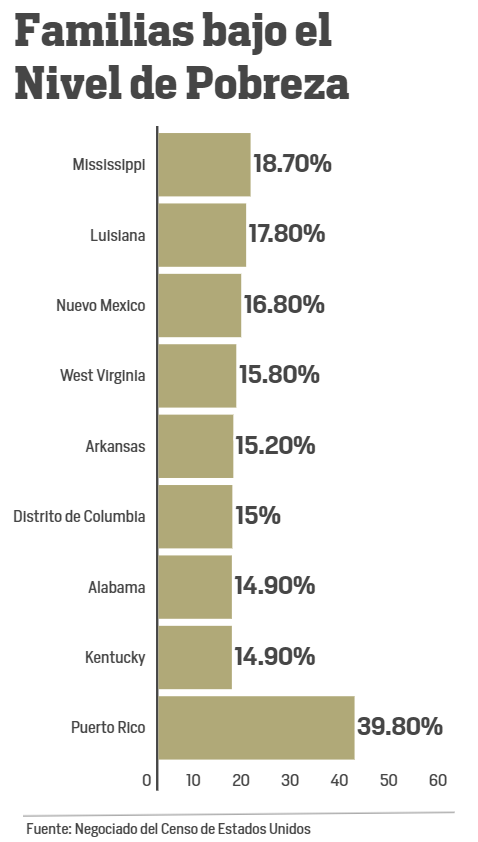
8/4/09 TOA BAJA, Residents of Villa de Sol, who will be evicted because they are on invaded land, in the photo (El Nuevo Día/Mariel Mejía Ortiz).
Poverty in Puerto Rico continues to be an issue that has received little public attention and lacks public policies to address it. Perhaps the abundance of state and federal aid has created the false perception that this social evil has been eradicated on the island. Poverty is a condition of life in which human beings are deprived of their economic rights, preventing them from developing as persons and from possessing those material elements such as clothing, housing, drinking water and food that are clearly necessary for subsistence.
During the second half of the 20th century (1950 - 2000), a period in which the economy achieved sustained growth rates, poverty appeared to be gradually reduced. From extreme poverty, the "economic miracle" allowed for vertical socioeconomic mobility, and in the 1970s the poverty rate stood at 62.8%. Eventually, between 1980 and 2000, it dropped from 59.8% to 44.6%.
During the past two decades, the economic stagnation experienced by the island has prevented the poverty rate from maintaining a downward trend. Currently, the federal poverty rate stands at 39.8%, according to 2021 data from the federal Census Bureau.
Another significant fact is that the Gini index in Puerto Rico, an instrument that measures the distribution of income in a society, reflects a value of .55, the highest in the United States. The closer to 1, the greater the inequality with respect to income. For that year, on the mainland, the Gini index was .48, with the District of Columbia being the jurisdiction with the highest index after Puerto Rico, with .52.
The socioeconomic lag with respect to the United States is worrisome.
Today, Puerto Rico remains the poorest jurisdiction in the United States by federal standards. By current standards, a family of four with an income of $26,500 or less per year is below the poverty line. By that definition, four out of every 10 families in Puerto Rico are socioeconomically disadvantaged.


The poverty situation is worrisome if we take into account that the poverty level in the United States, of which we are a part, is 14.4%. Puerto Rico is even poorer than the poorest states in the continent, such as Mississippi (18.7%), Louisiana (17.8%), New Mexico (16.8%) and Alabama (14.9%), among others.
Clearly, the structural poverty experienced by 40% of the Puerto Rican population will maintain a permanent lag with respect to our fellow citizens in the north and represents a stumbling block to any decision made by the federal Congress regarding the island's political future. The socioeconomic duality seems to be rooted in the failure of the economic model, welfare policies and the fact that the welfare state has also failed.
Public policies that produce poverty
The poverty experienced by the island is anchored in public policies that, far from solving it, expand and deepen it. First, the public education system has been thrown at a loss by the Puerto Rican political class. The millions in fiscal resources allocated to the Department of Education ($2.8 billion), far from reaching the classroom, remain halfway, in contracts that do nothing to help educational management. The result is that, far from providing tools for young people to access college and achieve socioeconomic mobility, the education system forms new generations of students who are left behind and marginalized in the vicious cycle of poverty.
Second, for decades, the state preferred to promote local and federal financial aid as a response to poverty. As a result, instead of being a temporary mechanism for transitioning to self-sufficiency, welfare has become a powerful incentive that discourages work and economic progress.
The state has preferred to exercise its paternalistic role towards the 40% of the population living below the poverty level as a mechanism of social and political control. Economic aid wrapped in a populist discourse has become a powerful electoral instrument. Aid in exchange for votes has been a powerful pairing in island politics since ancient times.
Finally, the narrative outlined by the state and the political class that punishes those who progress and criminalizes wealth creation, seal the recipe for the socioeconomic failure of the island that was once a model of industrial and economic transformations.
At a time when the federal government's checkbook is showing signs of fatigue and financial unfeasibility, it seems to me that the message is more than clear: it is urgent to seek alternative routes to eradicate poverty and to build a new paradigm based on education, work and production.
This opinion article was published in Spanish by El Nuevo Día.

